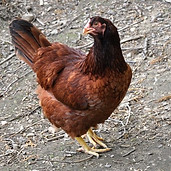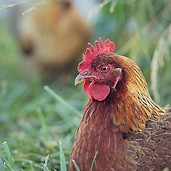
Sunshine Chicken Farm












Black Copper Marans
The Marans breed is named for the historic southwestern port town of Marans, France, where it originated in the 1920s. A somewhat rare breed in America, it was not adopted into the American Poultry Association as a standard until 2011. The Black Copper Marans is the most popular of the breed by far, but other Marans could be white or wheaten. Marans are very active birds that make great free-range foragers. They are also quite intelligent, friendly, and calm chickens and would make a good starter chicken as they are quite a friendly, docile breed that is rather low maintenance. This breed is a good egg layer and tops out at 180-210 per year. Known for their distinctive rich, chocolate brown eggs, they are a favorite among chefs and farmers alike.
Buckeye
A dual-purpose hen that thrives in the cold! The Buckeye chicken has the distinction of being the only breed to have been created by a woman. Buckeyes will give you around 200 eggs each year. They can be butchered as young as 16 weeks and can dress out to a respectable 7-9lb bird. The Buckeye is a breed originating in the late 19th century in the U.S. state of Ohio. Around 1896, Nettie Metcalf, a resident of Warren, Ohio, crossbred Barred Plymouth Rocks, Buff Cochins, and some black-breasted red games to produce the Buckeye. They are very active, curious birds that love to be around people and other animals. They are also excellent hunters that will hunt for and catch mice. Their friendly, curious nature makes them excellent pets as they have been known to jump into their humans’ arms and poke their beaks in to find out what is going on. Buckeyes lay about 200 medium-sized brown eggs per year and are very cold hardy; egg-laying continues through the winter months.
Cochin
Cochin first originated in ancient China and has also been known as “Shanghai” birds or “Cochin-Chinas.” Introduced to the West in the mid-1800s, they were partly responsible for the upsurge in the popularity of keeping chickens called “hen fever” in Britain and the US. Known as one of the ornamental breeds, cochins are bred in several color patterns: Buff, Partridge, White, Black, Silver Laced, Golden Laced, Blue, Brown, and Barred. Cochins are known to be quite peaceful and calm, easy to handle, and friendly, but are prone to broodiness, so they are not known for egg production. They average about 160 large brown eggs per year.
Cornish
The fluffy hen loves to be cuddled and can easily become a lap chicken. This bird would be suitable as a therapy bird. Cornish chickens originated from Cornwall County in England, and a heritage breed, the best guess for development was around 1820. They were introduced to America and became part of the APA Standard chicken in 1893. Intended initially as an all-purpose breed, their heavy body and muscular nature quickly gave rise to overwhelmingly meat-only chicken. Most domestic chicken used in the meat industry today is at least part Cornish chicken. Cornish temperament tends to be aggressive, loud, and active and is not usually recommended for the backyard chicken keeper. They are the quintessential meat chicken. They grow fast, too fast for their bodies to keep up; hence owners must butcher them to save them from suffering. They are ready to cull at 4-6 weeks and weigh around 8lb by this age. This bird’s downside is their high feed consumption, making them not so great in the feed ratio. Given that these hens are most used as a meat breed, you would not expect them to be the best egg layers. Cornish typically lay about 100-120 medium light brown eggs per year.
Dominique
The Dominique chicken breed was developed in New England from the fowl in the area. This breed is so old that no one can really say where it came from or how it was developed. Many believe that Dominiques came to this continent with the pilgrims, and they are sometimes called Pilgrim Fowl, but they were not recognized as a specific breed until the early 1800s. Dominique hens are known to be calm and reliable, but roosters can be quite protective. Some owners even report that roosters have killed small rodents, cats, or snakes! These hens lay a medium-sized light brown egg and can lay between 230-270 per year.
Easter Egger
The Easter Egger is not a recognized breed but rather any chicken that does not meet any poultry breed standard that has been defined by the American Poultry Association but has the “blue-egg” gene. The most popular crosses are various Ameraucanas, Araucanas, and Marans breeds. Due to a pigment deposit called oocyanin on the surface of the eggshell, the eggs have a green-blue tint. This color will vary depending on the breeds each is crossed with. For example, an Easter Egger crossed with a Maran that lays dark brown eggs will result in olive green eggs. They have even been known to lay pink, blue, and green eggs and different shade variations of those colors. Easter Eggers have a peaceful and friendly temperament. They love getting treats, and are easily trained to sit in your lap, and will even come running to see you. Not only is this breed docile and friendly, but Easter Eggers are also quite hardy. In addition to these wonderful and unique qualities, Easter Eggers usually produce over 200 large to extra-large eggs per year. They are a wonderful beginner chicken for the backyard flock.
New Hampshire
The New Hampshire chicken, named after its place of origin, New Hampshire in the United States, is a relatively new breed; admitted to the Standard of Perfection by the American Poultry Association in 1935. They represent a specialized selection out of the Rhode Island Red breed. Deliberately selected for early feathering, fast growth, maturity, and large egg size, and good meat conformation, certain strains were also noted for their vigor and hardiness. Although general temperament is friendly, docile, and easy to handle for humans, the New Hampshire is also competitive and aggressive in obtaining food, so not ideal in a mixed breed flock. They lay large brown eggs, approximately 200-280 eggs per year, and will lay throughout the year, actually being more prolific during the colder months.
Orpingtons
The Orpington chicken is a very calm and friendly bird. Never hurry to go anywhere, curious and will be your friend for life if you give her treats. William Cook developed the breed in the mid to late 1800s. He named them after his hometown, Orpington, England. The breed was a wild success, and within 10 years, Orpington Chickens were a mainstay of British poultry enthusiasts. Orpington Chickens were brought over to America at the turn of the century. The first Orpingtons shown in America in 1890 were black, followed soon after by buff. The buff color was the first Orpington variety recognized by the American Poultry Association in 1902. Orpingtons are large, peaceful, and quite friendly birds. They have been described as ‘lap chickens’ by many. They are great with children, and they also make good pet chickens. Orpingtons are also productive egg layers, producing 175-200 huge brown eggs per year.
Silkie
The Silkie chicken looks like a cuddly toy! Silkies have feathers that do not latch together, so they look like they are wearing fur, not feathers. They are friendly and cuddly too. The Silkie breed was documented in ancient China and known in those times as Chinese Silk Chicken. The first western recording of a Silkie sighting was by Marco Polo in 1298. He marveled about seeing a bird with black skin and “hair like a cat” on his travels to China. Through maritime trade and the Silk Route, the Silkies were taken west. Eventually, Silkies were bought to America and admitted to the Standard of Perfection by the American Poultry Association in 1874. Their characteristic downy feathers come in many colors, including white, black, blue, grey, gold, and porcelain. Silkies are one of the most friendly, docile, and calm chicken breeds. They are very unusual looking, described as “chickens with fur,” and amusing to watch. Silkies make excellent little pets and are tough for their size. They are easy to handle and love to be cuddled. Not the best for all conditions; however, Silkies are not cold or wet hardy and may stop laying in hot temperatures. Many Silkie owners use them for pets and so are kept most of the time indoors. They are mediocre egg layers and typically lay tiny crème colored eggs, not more than 120 per year.
Silver Laced Wyandotte
The Wyandotte breed was created in the United States in the 1870s. The very first variety of the Wyandotte to be created was the Silver Laced Wyandotte. Silver Laced was also the first variety of this breed to be accepted to the Standard of Perfection by the American Poultry Association in 1883. Wyandottes have good dispositions and are a healthy breed, so generally a good choice for families with backyard flocks. The temperament of the Silver Laced Wyandotte Chicken varies as it grows. Although young birds of this breed are mild-mannered and friendly, males can tend toward dominance if put in situations with other animals, chickens, or humans threatening the flock. Silver Laced Wyandotte hens lay nicely shaped, large eggs varying from light-to-rich brown, up to 260 per year.
Speckled Sussex
These chickens are thought to be brought over to England by ancient Romans 2000 years ago. In Sussex’s historic county, Sussex was standardized and perfected as a good dual-purpose chicken in the south-east of England, hence naming the breed for that location. Speckled Sussex chickens reached America about 1912 and were recognized by the American Poultry Association in 1914. Speckled Sussex is beautiful birds and appear more ‘speckled’ as they mature. As young chicks, they are marked much like a chipmunk. When the bird matures and feathers come in, they’re a beautiful mahogany color, with some tipped in white and others separating in black. With age and with each molt, the white tips multiply, and the birds become more and more speckled – giving the breed its name. They’re curious, the first to check out new situations, love environmental enrichment, and are intelligent pets. Many owners use cute, sweet, friendly, chatty, and entertaining words to describe the Speckled Sussex temperament. They are good egg layers and tend to lay large light brown eggs, 200–350 per year.
Welsummer
The Welsummer Chicken is a Dutch breed developed in the early 1900s and was named after the village of Welsum in Holland. This breed became widely known when their large and dark brown eggs were exported to other European countries for the commercial egg trade. Welsummer hens are justly famous for their very dark terracotta brown eggs, often speckled or spotted. Welsummers are still considered fairly new to North America, imported in the mid-1900s. The breed was admitted to the American Standard of Perfection in 1991. The personality of the Welsummer is confident but pleasant. They are not particularly docile but are quite intelligent and friendly. Hens lay about 160 dark brown or speckled eggs per year and are still popular for their beauty.